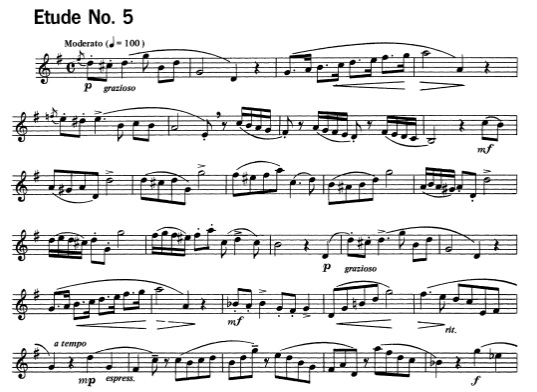The second All-State horn etude for 2016-2017 comes from the Legato Studies for French Horn book by John Shoemaker. It is relatively simple technically (at least, compared to the Kopprasch etude), but it does have its own unique set of challenges.
Let’s get started!
Music
Download a .PDF of this etude or buy the Shoemaker book from SheetMusicPlus.com.
Key Points:
Although this etude is not nearly as challenging technically as the first etude – this piece is not as easy as it first appears. This music is quite thoroughly marked with different dynamics, accents, and articulation – and you must be equally aware of these markings (and what they mean) when your practice this etude!
Here are some of the things to pay attention to:
- While this piece is technically faster than the other etude, the overall feeling of this etude is much more lyrical and song-like. You should not sound or feel rushed when playing this piece.
- There are lots of different and specific articulation and accent marks throughout the piece. These markings are as essential to the music as the notes and rhythms! Make sure you perform them equally as accurately and consistently as the notes!
- Notice the grazioso marking in both bar 1 and bar 17. Make sure you know what this word means. If in doubt – look it up! Also, notice the rit. In bar 23.
- Whether you put your grace notes on the beat or before the beat, make sure that they are consistent, although before may be a better idea musically.
- Keep your slurs connected – make sure that you keep your air moving between the notes. When practicing, it’s okay to make the slurs a little bit “glissando-like” in order to really get used to the air connecting the notes.
- Although there are some big interval skips in this piece, most are easy-to-hear intervals, like octaves, fourths, and fifths. Make sure that your note after a big jump is accurate!
Practice Tips
- Although there are lots of skips, they are (mostly) arpeggios. Make sure you know what arpeggio you’re playing (and that you know that arpeggio) and you’ll find that you’ll be able to tell quickly when you miss a note.
- If the large slurred and tongued intervals are a challenge, practice them as glissando slurs (even if they are tongued) to make sure you know the shortest path between the two notes. Once you can glissando accurately to the upper or lower note, then coordinate your fingering, airspeed, and articulation to remove the intervening
- If necessary, write in the appropriate fingering/enharmonic note for the E# (or any other notes).
- When practicing, notice the similarities between bars 9-12 and bars 13-16. Also, bars 1-4 and bars 17-20. There is really not much unique material in this piece, so make sure and really pay attention to the details (articulation, dynamics, accents, slurs) for each measure.
Listen
Looking for more help? I offer horn lessons both in-person and online! Check out my French horn lessons page for more information!


